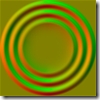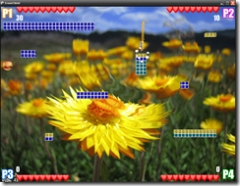Tonights coding efforts have born much fruit, I managed to finally generate a decent texture to use for base of the shockwave effect and roughly impliment the effect in game.
The in game result is as good as I’d hope, it still needs a thumping sound effect to give it real punch but I think I’m on to a winner.
 The first trick to the effect is trying to get your head around the base texture (to the right), I’ve used a the same technique they use for bump and nornal mapping, where the texture map doesn’t hold colour information it stores offsets for the sampling co-ordinates of the background texture.
The first trick to the effect is trying to get your head around the base texture (to the right), I’ve used a the same technique they use for bump and nornal mapping, where the texture map doesn’t hold colour information it stores offsets for the sampling co-ordinates of the background texture.
Red from 0 to 255 stores the X axis offset and Green the Y, the baby poo tan/green in the middle and the outside on the texture is Colour R128 G128 B0 A255 right in the middle, in other words no offset.
First up I tried using photoshop to generate the texture with overlapping gradients, but I couldn’t get the results I was after so I ended up using XNA to generate the texture on screen and saved it out with the handy Save() method of Texture2D.
Here’s the shader I use to apply the offset texture to the back ground texture:
uniform extern float4x4 World : WORLD;
uniform extern float4x4 ViewProj : VIEWPROJECTION;
uniform extern texture backGroundTexture;
uniform extern texture offsetTexture;
uniform extern float textureOffset;
struct VS_OUTPUT
{
float4 position : POSITION0;
float4 textureCoordinate : TEXCOORD0;
float4 P : TEXCOORD1;
};
sampler backGroundSampler = sampler_state
{
Texture = ;
MIPFILTER = LINEAR;
MINFILTER = LINEAR;
MAGFILTER = LINEAR;
};
sampler offsetSampler = sampler_state
{
Texture = ;
mipfilter = LINEAR;
};
VS_OUTPUT Transform(
float4 Pos : POSITION,
float4 Col : COLOR,
float4 TextureCoordinate : TEXCOORD0
)
{
VS_OUTPUT Out = (VS_OUTPUT)0;
Out.position = mul(Pos, mul(World, ViewProj));
Out.textureCoordinate = TextureCoordinate;
Out.P = Col;
return Out;
}
float4 ApplyTexture(float2 textureCoordinate : TEXCOORD0, float4 p : TEXCOORD1) : COLOR
{
float4 bump = tex2D(offsetSampler, textureCoordinate);
float2 perturbation = 0.5f - bump.rg;
float2 perturbatedTexCoords = textureCoordinate + perturbation / 25.0; // modify this division value for more or less effect
float4 c = tex2D(backGroundSampler, perturbatedTexCoords);
return c;
}
technique TransformTechnique
{
pass P0
{
vertexShader = compile vs_1_1 Transform();
pixelShader = compile ps_2_0 ApplyTexture();
}
}
